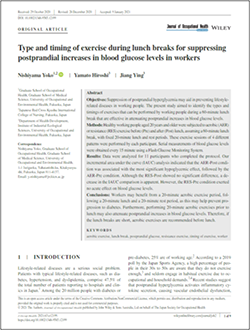#0121 Type and timing of exercise during lunch breaks for suppressing postprandial increases in blood glucose levels in workers

How to Best Weave Light Exercise into Your Lunch Break to Prevent Diabetes
In Japan alone, about 20 million people are diabetic or pre-diabetic, many of which are of working age. There are two important factors that help prevent one from developing diabetes and some cardiovascular diseases: regular exercise and suppressing glucose spikes after eating. While the former of the two is widely known and studied, the latter has only recently been identified as a potential way to battle diabetes.
When one eats a meal, glucose levels generally rise well over normal levels during the following hour before being regulated back down by insulin. While some studies have reported that post-meal glucose levels can be reduced via exercise before or after the meal, the results have been somewhat inconsistent. There are still many open questions, such as which type of exercise would be most effective or if the exercise should be done before or after the meal for best results. In our study, we aimed to answer such questions.
We recruited 11 healthy workers who had regular 60-minute lunch breaks and had them wear a glucose sensing system over the course of our experiments. We designed two types of 20-minute exercise routines that could be done easily in the workplace during lunch break: aerobic exercise and resistance exercise. The former involved walking at a medium pace of 6 km/h, whereas the latter involved a series of pushups, squats, and front bridges. The participants performed the exercise routines either before lunch or after a 20-minute rest following lunch (to leave time for digestion).
Through statistical analyses of the overall results, we found that light aerobic exercise after a meal was best for keeping post-meal glucose levels down. This means that workers with 60-minute lunch breaks can easily incorporate a bit of walking exercise after eating to help prevent complications caused by glucose spikes, of which diabetes is a common one.
Additionally, we found that aerobic exercise before a meal was also effective at maintaining lower glucose levels, albeit less than exercising after the meal. Workers with shorter lunch breaks could opt to exercise right before eating, rather than right after, to avoid problems with digestion. Finally, resistance exercise pre- or post-lunch did not have a very significant impact on glucose levels after eating.
Overall, our study sheds some light on how short periods of aerobic exercise before or after eating could mitigate progression to diabetes, which has become a noteworthy problem in modern societies.

Link to the original journal article:
https://onlinelibrary.wiley.com/doi/full/10.1002/1348-9585.12199
Title of the paper:
Type and timing of exercise during lunch breaks for suppressing postprandial increases in blood glucose levels in workers
Authors:
Nishiyama Yoko, Yamato Hiroshi, Jiang Ying




